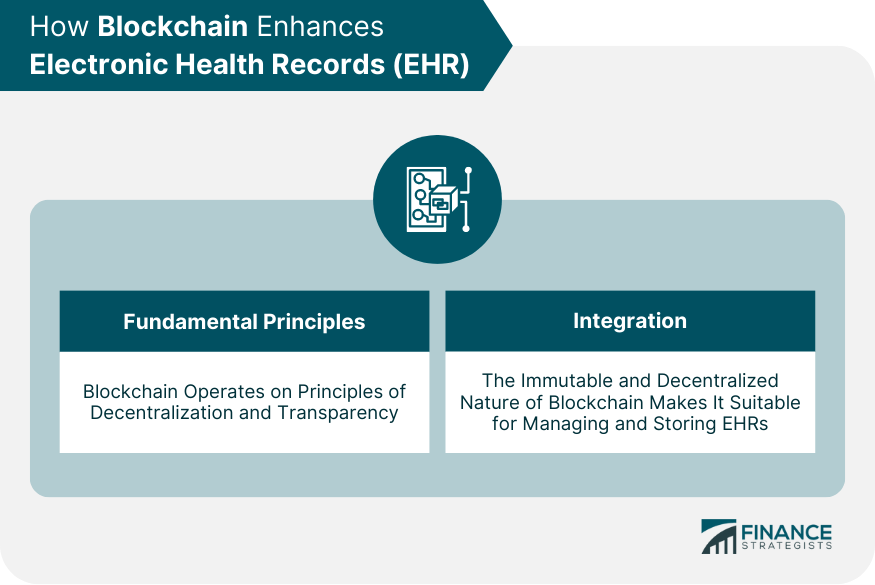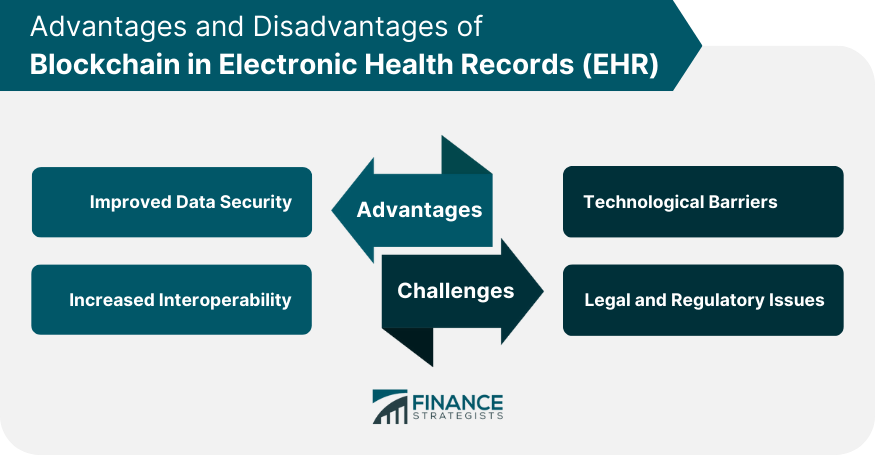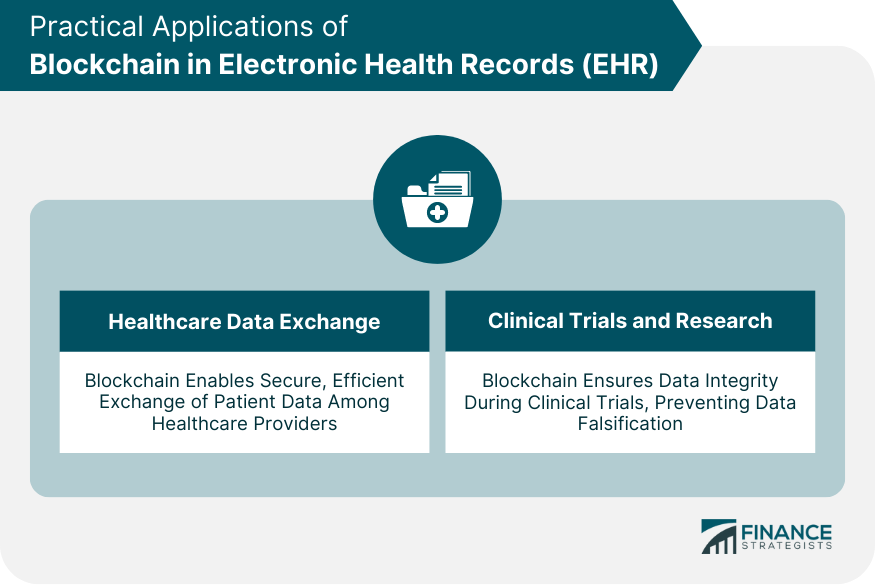Blockchain is a type of distributed ledger technology that securely records transactions across multiple computers. It employs cryptographic techniques to ensure data integrity, prevent unauthorized access, and facilitate transparency. Each 'block' of data is connected in a 'chain' to the previous and following blocks, thereby creating a complete, unalterable history of all transactions. Electronic Health Records (EHR) are digital versions of a patient's medical history that healthcare professionals update over time. They contain the status of a patient's medical and treatment history in real time and provide a comprehensive view of a patient's care. EHRs are patient-centered records that make information available instantly and securely to authorized users. The purpose of integrating blockchain with EHR is to enhance the security, privacy, and interoperability of health data. This synergy can help in the secure transmission of medical records, ensuring data integrity while preserving patient confidentiality. EHRs play a vital role in healthcare, enhancing patient care and enabling evidence-based decision-making. They contain information such as diagnoses, medications, treatment plans, immunization dates, allergies, radiology images, and laboratory and test results. EHR systems can help organize patient information and create a broader picture of patient care. Blockchain operates on principles of decentralization and transparency. Instead of storing data in a central location, blockchain distributes data across a network of computers. This decentralized approach ensures that no single entity has complete control over the entire chain. Another core principle is the use of advanced cryptography to secure data transactions. Cryptographic techniques make it nearly impossible to alter or falsify a transaction once it has been added to the chain, ensuring high levels of data integrity and security. Blockchain's immutable and decentralized nature makes it a suitable technology for managing and storing EHRs. First, in data recording and verification, each medical record can be encoded and securely added to the blockchain, which maintains a time-stamped record of each transaction. This secure and transparent process allows for easy verification of medical information. Second, blockchain can help in ensuring patient privacy. Though the blockchain is transparent, data can be anonymized to maintain patient confidentiality. Patients can control who can access their health information, enhancing privacy and trust in the system. The primary advantage of applying blockchain in EHR is the improvement of data security. Blockchain's unique structure and cryptographic features make it resistant to tampering, enhancing the security of medical records. Once a transaction is added to the blockchain, it becomes permanent and cannot be altered, ensuring the integrity of the health data. Additionally, the use of cryptographic techniques ensures that medical data is encrypted and secure. This encryption protects the data from unauthorized access and potential cyber threats. Blockchain can increase the interoperability of EHR systems. It enables seamless and secure sharing of data among healthcare providers, even when different EHR systems are in use. This interoperability can improve the coordination of care, particularly for patients with complex conditions that require the services of multiple providers. Furthermore, blockchain can empower patients by enabling them to access their health data easily and securely. They can control who has access to their data, improving patient engagement and health outcomes. Despite the potential advantages, several challenges must be overcome to integrate blockchain with EHR effectively. One major challenge is the inherent complexity of blockchain technology. It requires a high level of technical knowledge and understanding, which may not be widespread in healthcare institutions. Moreover, the high computational power required to maintain a blockchain can also be a limiting factor. A lack of technical expertise in healthcare institutions can also hinder the adoption of blockchain. Healthcare professionals may find it challenging to understand and use blockchain-based EHR systems, which can slow adoption and effective utilization. Legal and regulatory issues also pose challenges in the adoption of blockchain in healthcare. One such issue is the question of data ownership. The decentralized nature of blockchain raises questions about who owns the data and who is responsible for its accuracy and integrity. Another challenge is compliance with privacy laws, such as the Health Insurance Portability and Accountability Act (HIPAA) in the U.S. These laws require healthcare providers to protect patient information, and it is unclear how these requirements align with the transparent and immutable nature of blockchain. Blockchain can be a game-changer in healthcare data exchange by enabling a secure and efficient exchange of patient data among healthcare providers. This exchange can reduce errors and improve the quality of care. Furthermore, blockchain's ability to ensure data integrity can increase trust in the system, encouraging more healthcare providers to join the network. Blockchain can also revolutionize clinical trials and research by ensuring the integrity of data collected during trials. It can prevent the falsification or alteration of data, which is a critical issue in conducting and publishing clinical research. Moreover, blockchain can facilitate research using anonymized patient data. By ensuring the anonymity and privacy of patient information, blockchain can encourage the sharing of data for research without infringing on patients' privacy rights. To overcome the technological barriers to blockchain adoption in healthcare, efforts are being made to simplify blockchain technology and enhance its scalability. These efforts aim to reduce the technical knowledge required to maintain and use a blockchain-based EHR system. In addition, enhancing technical knowledge in healthcare institutions is crucial. This can be achieved through training and education programs for healthcare professionals on blockchain technology and its applications in healthcare. Legal and regulatory measures can also help overcome challenges in integrating blockchain with EHR. Clarifying data ownership rules can ensure that data on the blockchain is accurate and reliable. Patients should have control over their data, while healthcare providers should be responsible for maintaining the accuracy of medical records. Regarding privacy laws, blockchain can be designed to be compliant with these regulations. Measures can be taken to anonymize patient data, ensuring patient privacy while maintaining the transparency and integrity of data on the blockchain. Blockchain technology's integration with Electronic Health Records (EHR) promises to revolutionize healthcare data management. Its key advantages include enhanced data security through cryptographic techniques and improved interoperability, enabling secure, seamless sharing of patient data among healthcare providers. However, achieving this integration is not without challenges, including the complexity of blockchain technology, the need for extensive technical expertise, and certain legal and regulatory implications. By tackling these issues by simplifying the technology, boosting technical knowledge in healthcare institutions, and resolving legal and regulatory concerns, the benefits of a blockchain-integrated EHR system can be realized. Such an innovative approach can significantly advance patient care, healthcare data exchange, and clinical research, thus shaping the future of healthcare technology.What Are Blockchain and EHR?
Purpose and Importance
How Blockchain Enhances EHR
Fundamental Principles of Blockchain Operation
Integration of Blockchain with EHR

Advantages of Blockchain in EHR
Improved Data Security
Increased Interoperability
Challenges of Integrating Blockchain With EHR
Technological Barriers
Legal and Regulatory Issues

Practical Applications of Blockchain in EHR
Healthcare Data Exchange
Clinical Trials and Research

Overcoming Challenges in Blockchain and EHR Integration
Technological Solutions
Legal and Regulatory Measures
Conclusion
Blockchain and EHR FAQs
Blockchain can enhance the security and interoperability of Electronic Health Records (EHR). By recording health data on a blockchain, we can create a secure, unalterable record of a patient's medical history, which can be accessed by authorized users, increasing the interoperability of health data.
Blockchain improves the security of EHR through its inherent cryptographic techniques and immutable nature. Once a medical record is added to the blockchain, it is permanent and cannot be altered, ensuring the integrity of the data. Additionally, cryptographic techniques encrypt the data, protecting it from unauthorized access and potential cyber threats.
The integration of blockchain with EHR faces several challenges, including the complexity of blockchain technology, a lack of technical expertise in healthcare institutions, and legal and regulatory issues such as data ownership and privacy law compliance.
Blockchain can revolutionize healthcare data exchange by enabling secure and efficient sharing of EHRs among healthcare providers. It can also improve clinical trials and research by ensuring the integrity and privacy of data collected, and preventing falsification or alteration of data.
The challenges can be addressed through technological solutions such as simplifying blockchain technology and enhancing technical knowledge in healthcare institutions. Legal and regulatory measures, such as clarifying data ownership rules and ensuring compliance with privacy laws, can also help in the successful integration of blockchain with EHR.
True Tamplin is a published author, public speaker, CEO of UpDigital, and founder of Finance Strategists.
True is a Certified Educator in Personal Finance (CEPF®), author of The Handy Financial Ratios Guide, a member of the Society for Advancing Business Editing and Writing, contributes to his financial education site, Finance Strategists, and has spoken to various financial communities such as the CFA Institute, as well as university students like his Alma mater, Biola University, where he received a bachelor of science in business and data analytics.
To learn more about True, visit his personal website or view his author profiles on Amazon, Nasdaq and Forbes.











